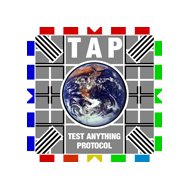tappy - TAP tools for Python¶

tappy provides tools for working with the Test Anything Protocol (TAP) in Python.
tappy generates TAP output from your unittest test cases. You
can use the TAP output files with a tool like the Jenkins TAP plugin or any other TAP
consumer.
tappy also provides a tappy command line tool as a TAP consumer. This tool
can read TAP files and display the results like a normal Python test runner.
tappy provides other TAP consumers via Python APIs for programmatic access to
TAP files.
For the curious: tappy sounds like “happy.”
Installation¶
tappy is available for download from PyPI. tappy is currently supported on Python 3.7, 3.8, 3.9, 3.10, and PyPy. It is continuously tested on Linux, OS X, and Windows.
$ pip install tap.py
TAP version 13 brings support for YAML blocks for YAML blocks associated with test results. To work with version 13, install the optional dependencies. Learn more about YAML support in the TAP version 13 section.
$ pip install tap.py[yaml]
Quickstart¶
tappy can run like the built-in unittest discovery runner.
$ python -m tap
This should be enough to run a unittest-based test suite and output TAP to the console.
Documentation¶
- TAP Producers
- TAP Consumers
- TAP Syntax Highlighter for Pygments
- Contributing
- Alternatives
- Releases
- Version 3.2, To Be Released
- Version 3.1, Released December 29, 2021
- Version 3.0, Released January 10, 2020
- Version 2.6.2, Released October 20, 2019
- Version 2.6.1, Released September 17, 2019
- Version 2.6, Released September 16, 2019
- Version 2.5, Released September 15, 2018
- Version 2.4, Released May 29, 2018
- Version 2.3, Released May 15, 2018
- Version 2.2, Released January 7, 2018
- Version 2.1, Released September 23, 2016
- Version 2.0, Released July 31, 2016
- Version 1.9, Released March 28, 2016
- Version 1.8, Released November 30, 2015
- Version 1.7, Released August 19, 2015
- Version 1.6, Released June 18, 2015
- Version 1.5, Released May 18, 2015
- Version 1.4, Released April 4, 2015
- Version 1.3, Released January 9, 2015
- Version 1.2, Released December 21, 2014
- Version 1.1, Released October 23, 2014
- Version 1.0, Released March 16, 2014